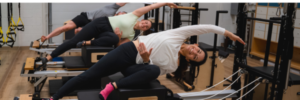Whether you are trying to do jumps and spins on the ice, race your opponent to get to the puck in the corner, or simply enjoying a stroll on a lake in the Okanagan, proper alignment is key to performing at your best and preventing injury!
Skate Structures
Figure skates are rigid, and are composed of a boot that sits at a slight downwards angle, and a blade that is curved with a mighty (and sometimes dangerous) toe pick at the end. The boot itself has no forefoot rocker; instead, that rocker is built into the shape of the blade. When you see a skater spinning effortlessly and it seems like they could spin forever, they are spinning at the peak of their forefoot rocker, or the “ball” of their blade. There is also a rearfoot rocker near the heel on the blade.
Hockey skates are more flexible and lighter than figure skates, and the blade is more strongly curved with the rocker being set closer to the middle of the foot. This design allows for the player to gain speed, turn and stop more quickly on the ice.
The rigidity in both of these skate boots can be detrimental to skaters causing their ankles to be more prone to injury. It is common to have skates professionally stretched or “punched” in certain areas (ex, ankle bones, bunions) to allow for a better fit and less pressure on the sides of the foot and ankle. By properly aligning the foot in the skate, the chances that the biomechanics of the foot and the ankle will cause injury can be reduced. Both figure skaters and hockey players are prone to overuse injuries such as sprains, strains, bursitis and tendinitis. When a muscle becomes overworked or tired, it loses its ability to effectively absorb shock, therefore bones take an additional amount of force which can lead to stress fractures.
Other common injuries with these sports include chronic knee pain, low back pain and repeated groin pulls (more so for hockey players). These overuse injuries typically come from fatigue, therefore preventing these issues from the feet up can not only prevent injury but improve your performance.
Why Orthotics?
Figure skating and hockey both require a significant amount of training on and off the ice. Orthotics can give these athletes a greater chance at reducing the quantity and severity of their injuries. An over-the-counter insole or a custom made orthotic that is moulded to the shape of the foot can have numerous benefits.

Without an orthotic, your arch can drop causing your foot to roll down and inwards when pushing off until it hits the inside of the skate. Not only can these motions cause excessive strain on the foot and other structures, it also causes an inefficient stride! An orthotic allows contact with your arch therefore not allowing your foot to roll down and inwards. Thus, your pushing energy coming from your legs is immediately transferred through the orthotic, into the skate and then into the ice. Dryland training is to improve power output and performance on the ice. It would be a waste if arch collapse or other foot mechanics during skating were the limiting factor to why this hard work wasn’t being properly transferred! Also, who wouldn’t prefer to be a faster skater while conserving more energy!
Orthotics improve the comfort within the skate, improve pressure distribution on the bottom of the feet, reduce pressure points which further allows blood to flow better. The take-offs and landings of jumps for figure skaters causes a significant amount of force on that foot. Distributing these pressures with an orthotic can help to offload the toe bones, thereby reducing the risk for stress fractures.
There are many reasons to be interested about improving your performance and/or decreasing pain and injury by introducing orthotics into your skates. Our pedorthists would be happy to discuss custom orthotics and other recommendations for your hockey or figure skates!
Click here to book an appointment with one of our Certified Pedorthics: https://www.orthoquestpedorthics.com/pages/pedorthics
Written by Kaleigh Hole C. PED (C)





